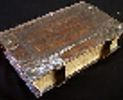Tonight is the 7th Night of Hanukkah, remembering the re-dedication of the 2nd Temple in Jerusalem, Israel. (Hanukkah is the Hebrew and Aramaic word for 'dedication'.) Jesus attended this annual dedication at the Temple in Jerusalem.
Today is Shabbat (Sabbath) and since lighting candles is considered work, and you are not supposed to work on the Sabbath, the closing of the Sabbath will be at Vespers, with the Antiphon replacing our usual Psalm 33, then we light the Hanukkah candles at Compline (Supper). Hanukkah candles are lit later on this particular night only after Shabbat (Sabbath) offically ends. We don't have to be as legalistic as the Jews are about these things, given Jesus teachings on the Sabbath.
Many Jews this year will be fearful of displaying their Hanukkah lights because of the rise in anti-semitism, especially after the attack in Australia. Please show your support for the Jewish community by lighting and displaying candles for Hanukkah - Don't let the darkness of Hatred win.

.jpeg)

 Welcome
Welcome Calendar
Calendar Today's Word
Today's Word Lauds
Lauds Terce
Terce Sext
Sext None
None Vespers
Vespers Compline
Compline Matins
Matins
